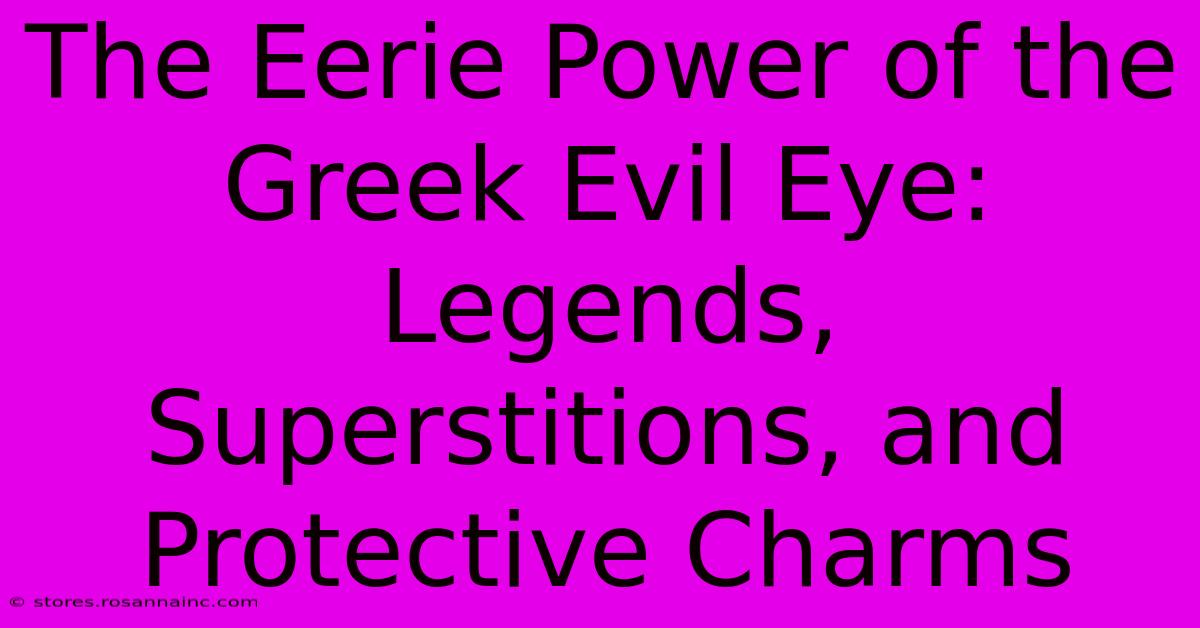The Eerie Power Of The Greek Evil Eye: Legends, Superstitions, And Protective Charms

Table of Contents
The Eerie Power of the Greek Evil Eye: Legends, Superstitions, and Protective Charms
The Greek evil eye, or mati, holds a powerful sway over Greek culture, a potent symbol woven into the fabric of daily life for centuries. More than just a superstition, the mati represents a deep-seated belief in the power of envy and the need for protection against its malevolent effects. This article delves into the legends, superstitions, and protective charms associated with this compelling aspect of Greek folklore.
Understanding the Malevolent Gaze
The core of the mati belief lies in the power of a malevolent gaze. It's believed that someone filled with intense envy or admiration can unintentionally inflict harm – physical or otherwise – simply through their stare. This isn't malice; it's an uncontrolled, almost accidental unleashing of negative energy. The victim, unaware of the envious gaze, may experience sudden illness, misfortune, or a streak of bad luck. This makes the mati a unique form of hex, less a deliberate curse and more a consequence of uncontrolled negative emotion.
Legends and Myths Surrounding the Evil Eye
Numerous legends surround the mati, often involving tales of unexpected illness or misfortune striking those who have inexplicably attracted the envious eye. Stories are passed down through generations, reinforcing the belief in its power and the necessity of protection. These narratives aren't just spooky campfire tales; they serve as cautionary reminders to avoid boasting about one's successes and to maintain a healthy dose of humility. The underlying message emphasizes the importance of community and mutual respect, discouraging behaviors that might inadvertently trigger the unleashing of the mati.
Recognizing the Signs of the Evil Eye
While the effects of the mati are varied, some common signs are believed to include:
- Sudden illness: Unexplained fevers, aches, or general malaise are often attributed to the evil eye.
- Unfortunate events: A string of bad luck, accidents, or financial setbacks can be interpreted as a sign of the mati.
- Restlessness and anxiety: Unexplained feelings of unease and anxiety can also be linked to its influence.
It's important to note that these symptoms are not exclusively attributed to the mati. However, within the cultural context of Greece, they often prompt a consideration of its potential influence.
Protection from the Evil Eye: Amulets and Charms
Throughout Greece, you'll find a wide array of amulets and charms designed to ward off the evil eye. These aren't merely decorative; they are tangible expressions of faith and a belief in their protective power. The most common include:
- The mati itself: Ironically, a depiction of the evil eye – often in the form of a blue, glass eye – is frequently worn as a charm. The theory is that it deflects the negative energy directed towards the wearer.
- Hand-shaped amulets ("Hamsa"): These protective charms, also prevalent in other cultures, are believed to ward off evil and bring good fortune.
- Red ribbons and strings: Red is believed to have protective properties, and tying red ribbons or strings around objects or people is a common practice.
These charms are seen not just as personal protection but also as adornments for homes and businesses, acting as a collective ward against negativity. Their presence is a constant visual reminder of the belief and the community's shared concern for protection.
The Mati in Modern Greece
Despite modernization, the belief in the mati remains strong in Greece. It's deeply ingrained in the culture, a testament to its enduring power. While scientific explanation may not exist, the cultural significance of the mati is undeniable. It shapes social interactions, influences personal choices, and continues to offer a unique lens through which to understand Greek tradition and beliefs. The enduring presence of the mati speaks to the lasting power of cultural beliefs and the human need for protection against perceived threats, both seen and unseen. The fear of the mati is not about fear of a supernatural being, but rather a fear of the consequences of uncontrolled human emotions and a powerful reminder of the importance of community and respect.

Thank you for visiting our website wich cover about The Eerie Power Of The Greek Evil Eye: Legends, Superstitions, And Protective Charms. We hope the information provided has been useful to you. Feel free to contact us if you have any questions or need further assistance. See you next time and dont miss to bookmark.
Featured Posts
-
Neighborhood Watch How To Fight Solicitors And Maintain Community Harmony
Feb 06, 2025
-
Captivating Landscapes The Ultimate Guide To Epic Panoramas
Feb 06, 2025
-
The Best Gift You Can Give Festive Email Icons To Spread The Christmas Spirit
Feb 06, 2025
-
Unleash The Power Of Wednesdays The Ultimate Edge For Email Marketing Domination
Feb 06, 2025
-
Il Metodo Infallibile Per Ottenere Immagini Web Leggerissime Senza Perdite Di Qualita
Feb 06, 2025
